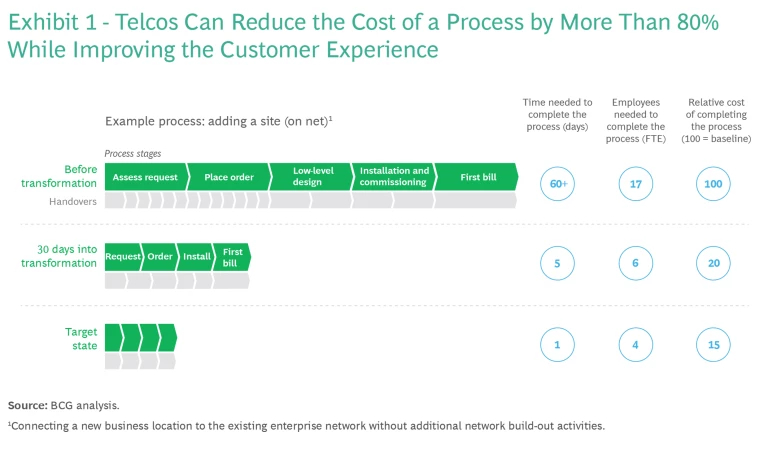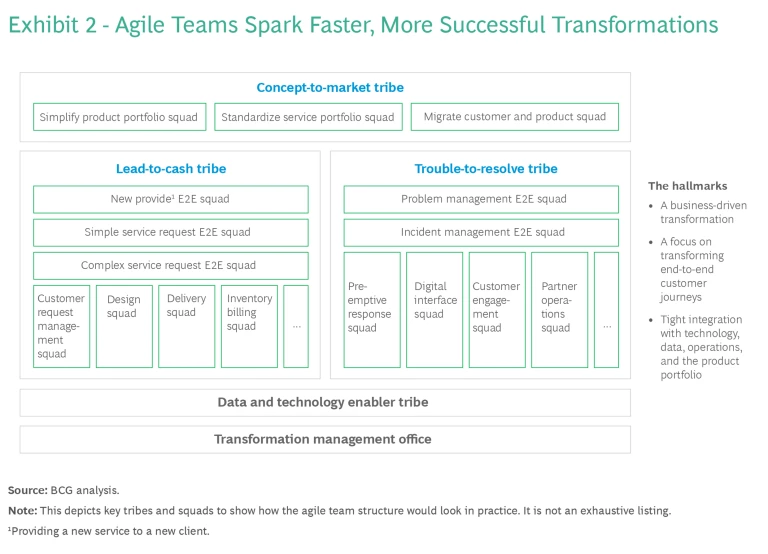For B2B telecom operators, customer satisfaction remains a work in progress. Unfortunately, the work is outpacing the progress. Telcos consistently score below other sectors on this key metric, earning them a standing—and a reputation—they’ve struggled to shake. Indeed, many providers have failed to raise a bar that’s so low, it could challenge the most dexterous limbo contestant.
Meanwhile, pressure mounts. Lean fiber players, system integrators, and hyperscalers —unencumbered by legacy processes or systems—can offer similar products but radically different experiences. And it’s not just new competitors tugging at the sleeves. Telecommunications companies are also under the gun to deliver significant cost savings.
These twin mandates—raise satisfaction, lower costs—haven’t played well together. In many cases, process redesigns trigger savings only to trigger customer frustration as well.
But what if telcos could avoid the tradeoff? And while they’re at it, improve the employee engagement that can flag when helping customers takes too long, involves too many hoops, and brings too little joy?
Making this work is possible and so, too, are tangible—and sizable—rewards. Telcos can reduce the costs of a process, such as provisioning, by 80% or more while moving the needle on satisfaction. (See Exhibit 1.) And they can start seeing results soon: in our experience, within three to six months.

But getting it right requires a new approach to transformation, where telcos think like both a customer and a CFO. It also means combining methods that, traditionally, telcos haven’t used in unison—or, quite likely, at all.
Transformation That’s Truly Transformative
Poor experiences, high costs, delays, and errors: they all trace back, in large measure, to inefficient processes. The solution would seem straightforward. Transform a process so that you reduce, or even eliminate, the waste.
The problem is, there are a lot of places to cut process waste—and a lot of ways to cut it. Where do you start? How do you sequence your efforts? What works well from both an internal perspective (lowering costs) and an external perspective (making customers happy)?
Telcos have struggled with these questions. The proof is in the track record. We’ve seen a wide variety of transformation projects, yet few have been truly transformative, bringing dramatic improvements in service and big reductions in costs. (See “The Pitfalls of B2B Transformations.”)
The Pitfalls of B2B Transformations
The Pitfalls of B2B Transformations
- Trying to transform within a function (such as service delivery), rather than end to end across a process (such as lead-to-cash)
- Focusing on internal needs and benefits, instead of taking a customer’s perspective
- Failing to leverage enablers—like a data and digital platform—from the start
- Fixing symptoms, not root causes
- Starting without a comprehensive, quantitative baseline
- Setting incremental targets—or even no target at all—instead of aiming for truly transformative change
- Moving ahead without sufficient engagement and accountability of senior business leaders
In our experience, that kind of step change requires an approach built on some essential cornerstones:
- A Holistic, End-to-End View. Look at the full process journey (for example, from when customers order a product to when they can use it) instead of focusing on a specific step along that journey.
- A Customer-Centric Perspective. Understand needs, preferences, and behaviors to zero in on what resonates—and what doesn’t—with customers.
- A Value-Oriented Viewpoint. Identify and quantify the waste within existing processes, as well as the benefits of potential changes. Aim for transformative—not incremental—change. Ask: How do I make this journey 80% cheaper and dramatically better?
- Cross-Functional Teams That Integrate Design and Delivery. Create teams that incorporate all the expertise (and decision rights) needed to design and deliver change. Such teams can work in rapid cycles: seeking feedback on each iteration and factoring it into the next—and better—version.
- A Data and Digital Platform to Enable AI—Including Generative AI . Liberate data from underlying systems, making it accessible across the telco and, crucially, available for driving AI use cases at scale.
What does a transformation program based on these ideas look like? In practice, it has three key dimensions: generating the required insight, setting the delivery process up for success, and enabling lasting change.
GENERATING INSIGHT
Journey transformations need the right perspective—or, more accurately, the right perspectives. When a telco bases change solely on what benefits the telco, the result is often a hit with the accountants but a miss with customers. Yet a transformation based solely on customer requirements can also disappoint. It may not be technically feasible to meet some expectations. Or the cost of meeting them may outweigh any uptick in satisfaction.
The key is to strike the right balance: optimizing journeys from both an internal (inside-out) and an external (outside-in) perspective. To do that, telcos need to apply three methodologies that don’t have a lot of history working in concert:
- Human-Centered Design. By focusing problem solving and solution design on customer needs, human-centered design (HCD) reveals pain points as well as opportunities for differentiation . The idea is to gain a deep understanding of customers—through techniques like ethnographic research (observing how customers interact with products and processes) and journey mapping—and use these insights to guide design. Companies that embrace HCD involve customers throughout the design process, implementing their feedback in cycles: first on mockups, then prototypes, and ultimately on fully built-out solutions.
- Activity Baselining and Volumetrics. Telcos also need to look inward so that they can understand their own pain points and opportunities as well. Getting this right means knowing the baseline. How much effort are teams currently spending on each process step? How does the effort for the full process correlate with the volume for that process (there’s often an inverse relationship)? Complicating matters further, effort can vary with different products—and soar when telcos deliver multiple products as part of a solution. It may take much more time, for instance, to provision Product A than Product B and more time still when telcos need to deliver them together. Traditionally, there’s not a lot of transparency here. Activity baselining raises the veil. By breaking down effort into its different dimensions (activities, products, contract types) and surveying managers on the permutations, telcos can better understand their true “effort spending” and make better decisions on where to focus first, then next.
- Value Stream Mapping and Process Mining. A second internal lens further informs the transformation roadmap. Often, telcos think a process works a certain way, but in practice, it doesn’t work that way. Or there are inefficiencies that aren’t apparent. Value stream mapping is a proven technique to unearth the challenges—and the not always ideal workarounds—that have crystalized along a process journey. It leverages input from the people on the ground who deal with these issues daily. Process mining, a data science technique, complements this analysis. Algorithms comb through data in event logs and other sources to create visualizations of existing processes. By understanding how processes are really functioning, telcos can better imagine how they might be improved. They also can develop a North Star to guide the transformation.
SETTING THE DELIVERY PROCESS UP FOR SUCCESS
Telcos tend to split transformation projects into two phases: design and delivery (with the implicit assumption that the delivery phase will be easy). But often, it’s only during delivery that issues become apparent. By then, the design team has likely moved on to its next project—complicating the fix.
Many transformations are also hindered by another common practice: focusing on specific functions or features without giving much—if any—consideration to how changes will impact the overall customer journey.
Many transformations focus too much on specific functions or features without giving much—if any—consideration to how changes will impact the overall customer journey.
A cross-functional end-to-end approach, leveraging agile ways of working, lowers both these barriers to success. This means structuring teams around the full change life cycle (concept, development, iterating, and scaling) as well as the full customer journey (sales, delivery, and service). Such teams will have all the necessary talent—and decision rights—to implement change so that they can iterate, scale, and create value quickly.
How would this look in action? To use the language of agile, different tribes cover different journeys (for example, lead-to-cash or trouble-to-resolve). Within each tribe, each squad is responsible for a specific capability (such as an efficient quoting process). This structure makes it easier to optimize the full process journey, instead of discrete steps. (See Exhibit 2.) It also enables telcos to create well-defined outcomes and clear accountabilities.

Because a squad includes all the expertise needed to design, develop, and deliver a capability, there’s a risk that the team can exceed the best-practice size (typically 12 to 15 FTEs). But given the importance of having those skills onboard, telcos should limit squad size only when performance degradation is apparent.
Other best practices are less negotiable:
- A Single Game in Town. At any time, telcos should have only one change program affecting process journeys. And they should support that program through a transformation management office (TMO). Beyond tracking progress—and ensuring governance—of transformation efforts, the TMO serves as a single source of truth for baseline and change-related data.
- A Business-Driven Transformation. Senior leaders should own the change program and actively lead it, instead of outsourcing that role to change or transformation functions. When a telco’s highest-level managers lead tribes, it eliminates the need for complex governance processes. And there’s another benefit: talent that might otherwise prefer a business-as-usual role may now find the transformation effort more attractive.
- Interlocking Targets. Telcos should synchronize KPIs—such as customer satisfaction scores and cost savings—between the transformation and business unit annual targets. This ensures that transformation efforts align with (and can be measured against) business goals.
- A Showcase for Talent—Not a Place to Park the B-Team. Transformation is a priority, and its talent roster should reflect that, with telcos drawing from the cream of the organization. Transformation is also a full-time activity. Tribe and squad members should be able to devote the bulk of their capacity to the effort.
- An Agile Incubator. Integrating change into the BAU environment is frequently a challenge. An agile incubator—a virtual and physical space where squad members can more easily collaborate—can double as a “model office” where telcos test changes in action and make final tweaks before wide-scale deployment.
ENABLING LASTING CHANGE
The best transformations create value quickly and build on that momentum, steadily deploying more changes and creating more value. Legacy technology hinders this effort. Yet building an all-new IT stack—a silver bullet, to be sure—is typically a multiyear endeavor. So how can telcos unlock value in the near term, even as they lay the groundwork for large-scale IT change?
How can telcos unlock value in the near term, even as they lay the groundwork for large-scale IT change?
The answer is to embrace three enablers:
- End-to-End Workflow Orchestration. At many telcos, workflows are built directly into business support systems and operations support systems or cover only a subset of journeys or products. Any change to a workflow requires telcos to adapt legacy systems that are notoriously difficult to modify and require long development processes. But by separating workflows from BSS and OSS and using an off-the-shelf workflow orchestration tool, telcos don’t need to touch the underlying IT. Flexibility and speed increase. Another advantage of orchestration tools: they’re built around a visual, no-code environment. That means that process designers and customer experience experts—who may not be programmers—can make changes directly, reducing the lead time from months to hours.
Generative AI-Enabled Automation and Copiloting. The advent of generative AI has unlocked a new level of transformative opportunities. While customer care and interaction are prime focal points for the technology, the list is growing and includes areas that, traditionally, have been hard to optimize. For example, telcos could use generative AI to produce network designs automatically. Or to create a copilot to analyze complex network data. Or to extract data from unstructured customer input (so that telcos can feed the data to other systems).
Generative AI also enhances robotic process automation (RPA). While RPA has plenty of potential—performing high-volume repetitive tasks that humans would otherwise perform—it hasn’t gotten a lot of playing time at many telcos. The problem: RPA works best for high-volume processes. But within B2B telcos, processes are typically so fragmented that the business case for RPA is weak. By simplifying and modularizing processes before migrating, and using generative AI to create the structured data that RPA needs, telcos can change the calculus and make RPA a much more attractive investment.
- A Data and Digital Platform. By separating data from underlying applications, a DDP enables a modular, use case approach to transformation. This dramatically accelerates value creation. Because telcos no longer need to identify where the required data resides (on which system, in which silo) and how to gain access to it, they can launch high-priority use cases quickly. And they can build on those early successes, adding new use cases and bringing online new capabilities that enable more advanced use cases (as the cycle repeats, capabilities—and value—continue to grow). Meanwhile, by decoupling data from core BSS and OSS, a DDP lets telcos steadily replace their legacy technology without disrupting the experience-layer transformation.
Under increasing pressure to improve experiences while cutting costs, telcos can no longer afford a tradeoff. By embracing a new approach to transformation—one that looks from the outside as well as the inside—telcos can create value where it matters most. And they can spark growth when it matters most.






